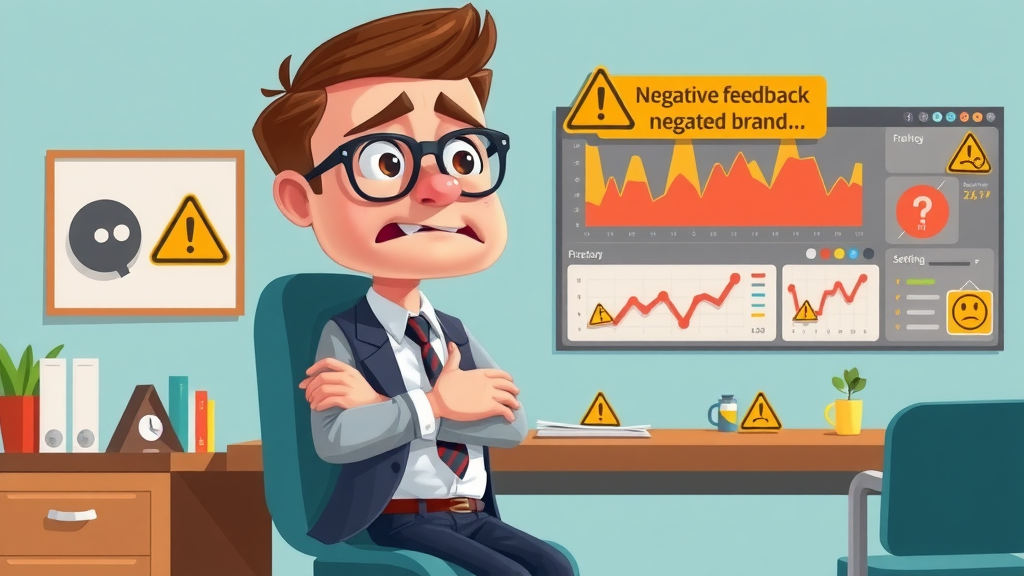Did you know that 88% of consumers trust online reviews as much as personal recommendations ? In today’s hyper-connected world, brand reputation management isn’t just a good idea—it's essential for safeguarding your business, building trust, and thriving in a digital-first landscape. If one misstep can drastically hurt not just your profits but your credibility, how can you proactively protect your brand reputation ? This guide unlocks the proven strategies to avoid common errors, maintain a positive brand image, and leverage customer feedback for long-term success.
Why Brand Reputation Management is Non-Negotiable in the Digital Age
- Latest statistics reveal that approximately 88% of consumers trust online reviews as much as personal recommendations, showcasing the undeniable impact of brand reputation management.
- Learn why a single reputation management mistake can lead to severe financial and reputational consequences, and how proactive strategies can safeguard your brand.
Brand reputation management is crucial because consumer perceptions can change rapidly on social media platforms and review sites . Just one negative review or viral comment can affect thousands of potential customers in hours. This is why leading companies employ robust reputation management strategies to actively monitor feedback, address complaints with empathy, and promote compelling positive stories. In a digital world where a brand’s image is shaped by both customer experience and public discourse, effective management is no longer optional—it’s a vital part of sustainable business success.

Overview: What You'll Gain from This Guide to Brand Reputation Management
- Clear understanding of brand reputation management and its three pillars
- Best practices for preventing and addressing errors in online reputation
- Actionable reputation management strategies for every size of business
- Expert advice on harnessing social media platforms and sentiment analysis tools
- Guidance on building a framework for positive reputation and customer loyalty
You’ll walk away with a blueprint that covers everything from the core principles of brand reputation management to rapid response techniques for negative feedback. Whether you’re a startup, local business, or major brand, this guide will help you build trust , cultivate customer loyalty, and harness the power of social and media platforms. Expect a mix of practical advice, real-world examples, and ready-to-implement tools to boost your online presence and maintain a positive brand image across all media platforms.

Decoding Brand Reputation Management: Foundations for Success
What Is Brand Reputation Management?
- Definitions and core elements of brand reputation management
- Role of online reputation in the digital ecosystem
- Interplay between brand reputation and customer experience
Brand reputation management involves shaping, monitoring, and influencing how your business is perceived both online and offline. At its core, it encompasses every interaction, mention, and review on social media , media platforms , and review sites . With the rise in digital interactions, a robust online reputation now sets the tone for how potential customers perceive your products or services. Strong reputation management ensures that every customer touchpoint, from their initial search engine query to engaging with your marketing campaign, consistently reflects your brand values and delivers a stellar customer experience.
Effective reputation management goes beyond crisis control. It involves a proactive approach to celebrate positive feedback, address negative reviews promptly, and foster brand advocates who amplify your positive brand message. Today, a single social post can reach far beyond your immediate audience, making the customer experience central to the narrative of your brand reputation . By integrating sentiment analysis and measuring real-time feedback, businesses can stay agile and responsive to their audience's needs and preferences.
Real-World Examples of Brand Reputation Management
- Case studies of successful and unsuccessful reputation management
- Lessons from global brands leveraging social media for positive brand perception
Consider a leading airline that faced a viral backlash following a passenger complaint on a social media platform . Rapid acknowledgment, public apology, and visible changes to policy helped regain customer trust and turned a negative scenario into a lesson in transparency. In contrast, some brands that ignored negative feedback on major media platforms witnessed long-term declines in customer loyalty and sales. Conversely, tech giants that actively encourage customers to leave positive reviews and constantly monitor their online reputation have experienced measurable gains in market share and customer satisfaction, proving the power of well-managed online engagement.

Understanding the Three Pillars of Brand Reputation Management
| Pillar | Description | Key Tactics |
|---|---|---|
| Monitoring and Measurement | Active listening and sentiment analysis of brand mentions across media platforms | Use sentiment analysis tools, monitor social media platforms, conduct regular audits |
| Response and Engagement | Timely, authentic engagement with customers on online and social media platforms | Publicly address concerns, offer resolutions, share transparent updates |
| Improvement and Prevention | Strengthening policies, securing digital presence, educating internal teams | Develop management strategy, train teams, safeguard digital assets |
The three pillars of brand reputation management provide a framework for sustainable growth and risk mitigation. Monitoring and measurement rely on continuous auditing of brand mentions and leveraging sentiment analysis tools to spot emerging trends or red flags. Response and engagement center on building genuine connections with your audience—responding to both praise and complaints in a way that strengthens public trust. Finally, improvement and prevention focus on organizing internal education, adapting strategies for changing market conditions, and reinforcing your digital presence to minimize future threats to your brand reputation .

Crafting a Robust Reputation Management Strategy for Modern Brands
Essential Components of a Reputation Management Strategy
- Clear objectives, stakeholder alignment, and resource allocation
- Integration with customer satisfaction and customer loyalty programs
Every strong reputation management strategy starts with clearly defined goals that align with your brand’s mission and values. Stakeholder alignment is crucial—your leadership, marketing, PR, and customer service teams must work in sync to deliver a unified brand image . Effective resource allocation, including assigning team members and investing in necessary tools, underpins rapid and coordinated crisis responses. Integrating your reputation management efforts with customer satisfaction and customer loyalty programs ensures that positive customer experience and repeat business become natural outcomes of your strategic approach.
Successful management strategies also include ongoing evaluations to strengthen weak points, incorporate feedback, and adapt to new digital challenges. By embedding reputation best practices into your daily operations and incentivizing employees to act as brand ambassadors, you strengthen your overall brand reputation management efforts.
Online Reputation Monitoring: Tools and Techniques
- Top sentiment analysis and social listening tools
- Identifying negative reviews and managing feedback across social media platforms
Monitoring your online reputation is more than just reading review sites . Modern sentiment analysis tools like Brandwatch, Mention, and Hootsuite enable brands to track conversations, monitor brand mentions on social media platforms , and receive instant alerts for negative feedback on any media platform. These platforms deliver insights to help you quickly detect emerging patterns, prevent issues from escalating, and celebrate positive customer engagement. Consistent monitoring across all channels—social, search engine results, online reviews, and direct customer feedback—ensures no signal is missed.
Managing negative reviews requires a structured approach. Designating staff to review feedback daily, using dashboards to capture sentiment, and maintaining templates for swift replies help maintain a positive online presence . Adopting a holistic management strategy that incorporates both qualitative and quantitative data from various media platforms can make your efforts scalable and precise.

Developing Effective Response Protocols
- Templates and escalation processes for addressing public complaints
- Leveraging media platforms to share positive stories and manage crises
Prompt, empathetic, and consistent responses are key to turning a negative review into a powerful testimony of your brand values. Each reputation management strategy should include response templates, escalation workflows, and clear communication guidelines to ensure brand voice consistency across all media platforms . When a crisis occurs, activating these protocols enables your team to provide timely updates, address concerns, and drive recovery efforts.
In addition, sharing positive stories—such as customer success stories or behind-the-scenes employee spotlights—on social media platforms can accentuate your positive brand image. Leverage every opportunity for transparency to show your audience the real people behind your products and services. Utilizing digital storytelling and influencer partnerships can further expand your reach and credibility during crisis response.

Common Brand Reputation Management Errors—and How to Prevent Them
- Ignoring social media conversations or negative reviews
- Inconsistent messaging across different media platforms
- Failing to actively measure customer sentiment and satisfaction
- Neglecting proactive management strategy adaptation
"A brand is no longer what we tell the consumer it is—it is what consumers tell each other it is." – Scott Cook
Some of the most damaging mistakes in brand reputation management stem from overlooking critical social media conversations or letting negative feedback pile up on review sites and dashboards. Failed responses or defensive attitudes on media platforms, as well as inconsistent messaging, can breed mistrust. Not implementing regular sentiment analysis means brands risk falling out of touch with customer expectations, while neglecting to update your management strategy can leave you vulnerable to repeat crises.
Prevention starts with dedicated staff monitoring feedback in real time, providing ongoing training in brand messaging, and fostering a culture of transparency. By empowering employees, maintaining open dialogues on all channels, and using data-driven insights, you can address and convert even negative feedback into a catalyst for improvement and renewed customer loyalty .

Harnessing Social Media for Enhanced Brand Reputation Management
The Role of Social Media Platforms in Brand Reputation
- How to maintain a positive reputation on key social media platforms
- Best practices for social media monitoring and engagement
Social media platforms are now the primary stage where brands interact with customers and the public. Maintaining a positive brand reputation here requires active participation—regular posting, authentic engagement, and consistent voice. Real-time monitoring of hashtags, mentions, and comments help brands spot emerging issues before they snowball and give you opportunities to amplify positive reviews or customer success stories.
Best practices include setting up alerts for your brand across all major networks, responding to enquiries within hours, and developing a uniform tone that reinforces your desired brand image . Training your social media team to identify trends, engage with customers constructively, and escalate potential PR issues quickly strengthens your defense and enhances your public profile.

Responding to Negative and Positive Feedback Effectively
- Do's and Don'ts of social media response
- Transform customer complaints into opportunities for positive brand exposure
When responding to customer feedback—whether positive or negative—it's essential to be genuine, respectful, and solution-focused. The do’s : thank users for their input, personalize each response, address issues publicly (then move to private channels if necessary), and follow up after resolving the complaint. The don’ts : avoid defensive or automated replies, never delete negative reviews unless they violate policy, and don’t ignore criticism hoping it’ll disappear.
Brands that master these nuances often turn critics into advocates. Taking responsibility, demonstrating empathy, and offering tangible solutions transforms potentially damaging interactions into proof that your business values its customers, which improves both brand reputation and customer loyalty .
Utilizing Social Media Advocacy to Build a Positive Brand
- Encourage employee and customer advocacy on social channels
- Incentivize user-generated content and testimonials
Authentic advocacy can do wonders for your positive brand reputation. Encouraging employees to share company culture online, celebrate product launches, and support brand causes widens your reach on social media platforms . Similarly, incentivizing customers to post user-generated content, leave online reviews, or share testimonials amplifies genuine voices supporting your brand.
Launching hashtag campaigns, contests, or rewards for positive mentions strengthens your organic footprint and builds community around your brand. The more real stories and endorsements you can collect and display, the more trust you foster, moving your reputation management strategy from reactive to proactive.

Measuring the Impact of Brand Reputation Management Efforts
Sentiment Analysis and Real-Time Metrics
- Introduction to sentiment analysis tools and their role in brand reputation management
- Quantitative indicators: engagement, brand mentions, share of voice
Effective brand reputation management demands constant measurement. Sentiment analysis tools evaluate whether people’s conversations about your brand are positive, neutral, or negative, providing real-time feedback for agile strategy adjustments. Key metrics to track include engagement rates (likes, comments, shares), volume of brand mentions, and your share of voice compared to competitors across various media platforms.
Regularly assessing these metrics allows brands to identify emerging opportunities, spot possible threats, and fine-tune their messaging. Combined with qualitative assessments, sentiment analysis keeps your management strategy data-driven and forward-looking.

Qualitative Metrics: Customer Experience, Loyalty, and Satisfaction
- Conducting reputation surveys and analyzing customer feedback
- Tracking improvements in customer loyalty and satisfaction over time
Quantitative data only tells half the story. Qualitative insights—gathered through customer feedback , surveys, and testimonials—provide the context needed to enhance customer experience at every touchpoint. Analyzing recurring themes in feedback not only reveals what customers love, but also identifies systemic issues that may be harming your online reputation .
Monitoring changes in customer loyalty and customer satisfaction scores over time showcases the tangible impact of your reputation management efforts. Focusing on the “why” behind customer opinions empowers you to adapt your offerings and service delivery for lasting, positive reputation.
Brand Reputation Management Case Studies: Lessons Learned
- Analysis of major brand reputation wins and losses
- Key takeaways from brands that achieved sustainable positive reputation through management strategy and customer experience focus
| Brand | Challenge | Management Strategy | Outcome |
|---|---|---|---|
| Brand A | Online backlash | Transparent communication and rapid response on social media platforms | Public trust restored |
| Brand B | Negative reviews surge | Proactive customer service and sentiment analysis | Satisfaction scores increased |
| Brand C | Social media crisis | Influencer engagement and loyalty incentives | Positive reputation recovered |
These case studies reveal the power of preparedness and agility. For example, brands that address visibility crises with transparency and quick action on social media platforms often recover far more quickly than those that delay or ignore feedback. Incorporating successful management tactics—including influencer partnerships, real-time sentiment analysis, and proactive customer service—can turn setbacks into defining moments that boost both public trust and long-term brand reputation .

Best Practices: How to Strengthen Brand Reputation Management Across Every Channel
- Establish unified voice and governance for online reputation
- Constant monitoring of media platforms and adaptation of strategy
- Empower employees as brand advocates through training
- Continually measure, learn, and improve using data-driven insights
- Maintain transparency with customers to foster loyalty and trust
To consistently deliver a positive brand experience, unify your brand voice and provide governance across every communication channel. Regular monitoring of all media platforms allows rapid identification of risks or opportunities. Investing in staff training turns your employees into reputation stewards, while constant data analysis enables ongoing improvements. Emphasizing transparency reassures customers, deepening both trust and loyalty over time.
Establishing a cycle of feedback, adjustment, and proactive innovation will ensure your reputation management strategy evolves alongside the digital landscape and customer expectations.
People Also Ask: How to Master the 3 Pillars of Brand Reputation Management?
- To master the three pillars of brand reputation management—monitoring and measurement, response and engagement, and improvement and prevention—brands must leverage technology for real-time monitoring, empower teams with effective response protocols, and foster a culture focused on continuous improvement. Integration of sentiment analysis across all media platforms and alignment with business objectives ensures your reputation management strategy protects and enhances positive brand perception.
People Also Ask: What Is Brand Reputation With an Example?
- Brand reputation is how a company is perceived by its customers and the public—both online and offline. For example, a company known for its quick and empathetic responses to customer issues on social media platforms likely enjoys a positive reputation, while one that ignores customer complaints risks damaging its credibility.
People Also Ask: What Are the Three Phases of Reputation Management?
- The three phases of reputation management are: assessment (measuring and understanding the current online reputation), improvement (addressing issues and building positive sentiment), and sustenance (maintaining best practices and continual monitoring of media platforms for potential threats).
People Also Ask: What Is the Difference Between Brand Management and Reputation Management?
- Brand management focuses on shaping and promoting the desired image, values, and identity of a brand, while reputation management is centered on monitoring, protecting, and enhancing how the public actually perceives the brand—especially in response to reviews and feedback on social media platforms and other media outlets.
Frequently Asked Questions on Brand Reputation Management
-
How do I recover from an online reputation crisis?
Respond quickly and transparently to all affected parties, acknowledge the issue, outline immediate steps taken, and update progress on all major media platforms. Leverage sentiment analysis tools to track recovery, encourage positive reviews from happy customers, and focus on rebuilding trust through consistent actions. -
What role does customer experience play in brand reputation management?
Customer experience is at the heart of effective reputation management. Satisfied customers share positive online feedback and drive word-of-mouth recommendations that build your brand image, while unresolved negative experiences can go viral and harm your brand reputation. -
Are there tools that automate sentiment analysis and monitoring?
Yes, tools like Mention, Brand24, Hootsuite, and Google Alerts automate monitoring and provide real-time sentiment analysis, making it easier to track mentions, reviews, and public opinion across multiple social media platforms and review sites. -
Can a small business effectively manage its online reputation without a large team?
Absolutely. With the right management strategy, small businesses can use free or affordable reputation monitoring tools, develop response templates, and delegate monitoring and engagement duties, ensuring their brand reputation management is just as effective as larger organizations.
Helpful Resources and Additional Guidance for Reputation Management
- Top recommended reading materials and tools for continuous learning
- Links to free sentiment analysis and reputation management strategy templates
To help you stay on the cutting edge of brand reputation management , explore books like "The Reputation Economy" by Michael Fertik and Mary Aiken or free online guides from top review sites. Download customizable sentiment analysis templates from trusted sources such as HubSpot or Sprout Social, and enroll in webinars or online courses for comprehensive learning on crisis management and digital advocacy.

Elevate Your Business with Proactive Brand Reputation Management
- Take the next step to secure your brand’s digital future by implementing a robust reputation management strategy and leveraging social media platforms for continual improvement. Reach out to our team for a customized brand reputation management consultation.
Start building brand resilience today—monitor, engage, and innovate for a future-proof online reputation that grows customer loyalty and trust.
 Add Row
Add Row  Add
Add 




Write A Comment